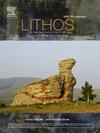Genesis of chromite deposit in the Sartohay ophiolite, NW China: Insights from chromite and its mineral inclusions
IF 2.9
2区 地球科学
Q2 GEOCHEMISTRY & GEOPHYSICS
引用次数: 0
Abstract
This study investigated chromite and its mineral inclusions from the Sartohay chromite deposit in NW China to explore the evolution of the parental magma and the genesis of the chromitites. Chromite grains in the Sartohay chromitite bodies have Cr# values (100 × Cr/(Cr + Al)) of 46.1–59.3, Mg# values (100 × Mg/(Mg + Fe2+)) of 47.3–70.5, and TiO2 contents of < 0.72 wt%, classifying them as typical high-Al variety. Numerous primary monomineralic and polymineralic inclusions have been identified within chromite, including olivine, clinopyroxene, orthopyroxene, amphibole, Na-plagioclase, and several less common minerals such as calcite, magnetite, magnesite, apatite, grossular, and corundum. The morphological features of these inclusions indicate that some were encapsulated as solid silicates, while others formed from melts trapped within chromite. The high Mg# characteristics of olivine and pyroxene inclusions, along with the zoning texture observed in elemental mapping images of amphibole inclusions, suggest that these inclusions have undergone elemental exchange with host chromite. The presence of crustal minerals, such as Na-plagioclase, indicates that crustal materials have been incorporated into the mantle through subduction recycling. The inferred parental melt compositions in equilibrium with chromite suggest that these chromitites likely formed from MORB-like melts. The interaction between this magma and harzburgites would generate a more silicic magma, from which high-Al chromitites formed.
求助全文
约1分钟内获得全文
求助全文
来源期刊

Lithos
地学-地球化学与地球物理
CiteScore
6.80
自引率
11.40%
发文量
286
审稿时长
3.5 months
期刊介绍:
Lithos publishes original research papers on the petrology, geochemistry and petrogenesis of igneous and metamorphic rocks. Papers on mineralogy/mineral physics related to petrology and petrogenetic problems are also welcomed.
 求助内容:
求助内容: 应助结果提醒方式:
应助结果提醒方式:


